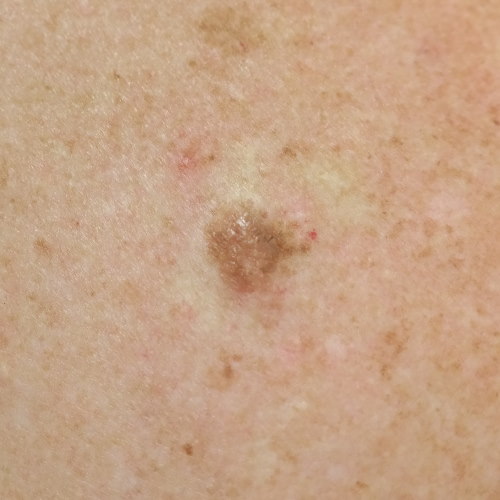Seborrhoeic keratosis (plural seborrhoeic keratoses) is a relatively common blemish. It can cause concern due to its strange appearance, which is often knobbly or wart-like and discoloured.
Also known as basal cell papilloma, a seborrhoeic keratosis is caused by a wart-like build-up of skin cells. It tends to be a darker colour than the normal skin and can look brown or even black in some cases.
In the UK more than half of men and over a third of women have at least one seborrhoeic keratosis. The likelihood of experiencing seborrhoeic keratosis increases with age, so by the time a person is 7o there is a 75% chance of having this skin lesion. It’s thought that they develop as a consequence of sun exposure. However, they can also affect younger people.
In some cases, the seborrhoeic keratosis can become infected or irritated. It may go red and can be sore and/or itchy. Where seborrhoeic keratoses catch on clothing, they can easily become irritated.
Despite being caused by skin cell issues, seborrhoeic keratoses are not generally medically worrying. They are not a form of cancer. However, they can sometimes resemble a type of skin cancer known as basal cell carcinoma. Therefore if there are any concerns, it is important to get the lesion checked out. A GP should refer the condition very quickly if it needs expert diagnosis.
Treatments for seborrhoeic keratosis are not funded by the NHS as they are deemed to be harmless from a medical perspective. However, patients dislike the look of them and are often keen to get rid of them for cosmetic reasons. This is an option in the private sector.
Treating Seborrhoeic Keratosis
Seborrhoeic keratosis may be treated in a number of ways, depending on the nature of the problem:
- Curettage – a procedure which involves ‘scraping’ the lesion away under local anaesthetic, before using cautery to stop the bleeding for fast healing and a neat result
- Surgical excision – large, stubborn blemishes can be treated with a minor surgery procedure. This ensures thorough removal of the lesion
- Laser treatment – laser works by destroying the lesions, breaking down the overgrowth of skin cells while also stimulating the skin’s own healing and renewal processes, leaving skin clearer and healthier-looking
- Cryotherapy – liquid nitrogen is used to freeze the lesions so that they drop off
These treatment options are available at Cosmedics Skin Clinics, where all treatments are carried out by skilled and experienced doctors. They can use local anaesthetic where required to keep the procedure pain-free. They will also know how to minimise the risk of long-term skin damage or scarring.






